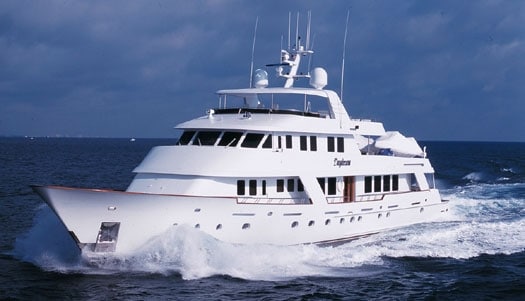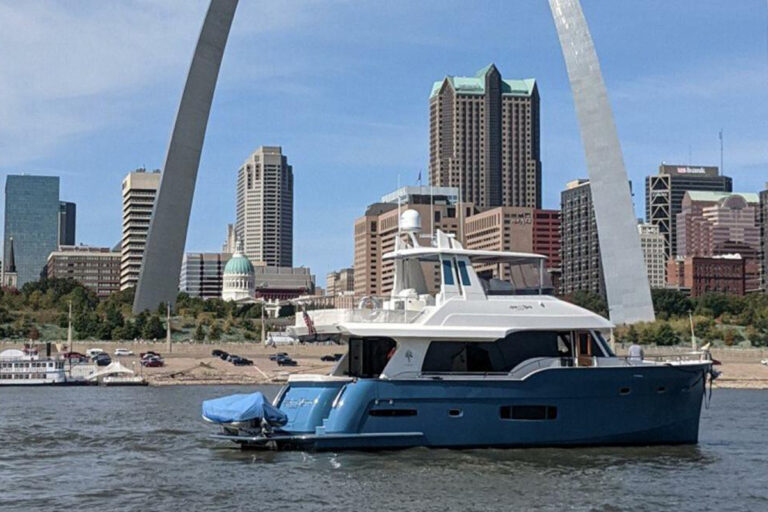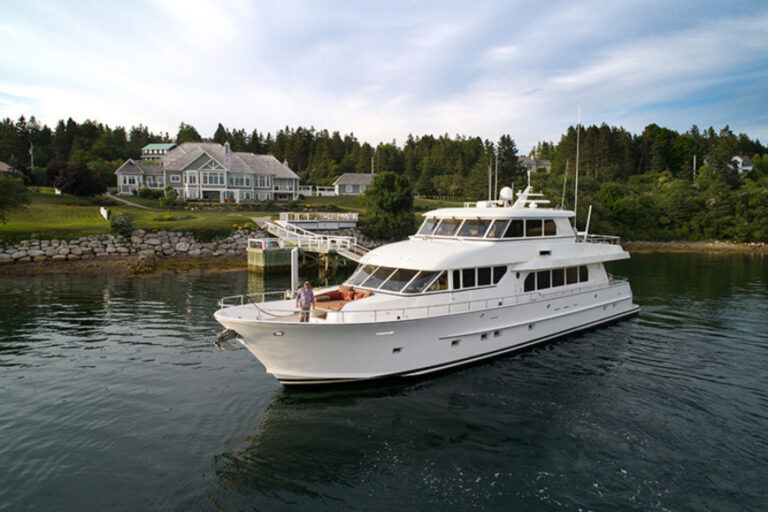
yachting/images/magazine/2005/082005/fea_christensen7_525x301.jpg
According to those involved, the project went like a dream-a Daydream, to be precise. That’s the new name of a 140-foot Christensen motoryacht, originally built in 1991 as Magnifico, that was recently modified and refit by a team of designers and craftsmen in south Florida. When the trideck yacht came on the market, Tony Cozier looked past her dated interior and saw two key elements for a successful refit: the composite vessel’s flexible arrangement and solid pedigree. Cozier has owned a number of yachts, several of which he has refit, but Daydream is his most extensive project yet. In addition to giving the yacht an updated look, he wanted to make changes to her interior layout and significantly expand her open spaces on deck.
Changes of this magnitude are never just cosmetic, and Cozier knew that they could create problems unless done properly. In hiring naval architect Kevin Kerwin, an experienced designer with whom he had worked previously, Cozier covered the bases and more-he was echoing the central tenet of modernism: “Make it new.”
Kerwin, in the redesign, extended the bridgedeck by 17 feet to provide shade for the seating and dining area abaft the skylounge on the upper deck and to create room for a bar, whirlpool spa and lounge area topside. As part of this expansion, the original mast was replaced with an arch, and a fiberglass hardtop was installed over the flying bridge helm area.
The new deck extension was joined to the existing deck with a scarf joint that tapers over a length of about four feet, providing the necessary structural continuity and allowing a gentle transition from the 2-inch foam core in the original deck. The large addition-a clear-span panel that is supported at the after end by three stainless steel stanchions-required a 3-inch core to maintain strength and stiffness.
Kerwin also cut down the bulwarks amidships on the main deck to improve the view from the saloon, foyer and dining room, restoring the area to a safe height with a stainless steel handrail atop the teak sheer cap. While the change seems straightforward, it was complicated. The area cut away was part of the original hull and had considerable shape. This required each stanchion supporting the new rail to be at a different angle, so a great deal of the work had to be done in place aboard the yacht rather than in the metalworking shop.
Cozier asked Kerwin to undertake much of the interior redesign as well, including the arrangement, most of the furnishings and some of the dÈcor. Kerwin had never before been granted such a complete interior design brief, but he agreed, subject to bringing in Bill and Anita Unger, of Anita’s Interiors, to collaborate. Both parties spoke highly of the other’s work to me, as well as the contributions of craftsmen Chris Rickborn, who completed much of the fiberglass work, and Dominic Beauilieau, who undertook all of the joinery.
Daydream‘s original joinery was primarily pickled ash with gold trim, but Cozier wanted teak or mahogany. After considering several options, Kerwin and the Ungers suggested a two-fold approach that Cozier embraced. The bulkheads of the main saloon and dining room would be sanded and re-veneered with sapelle mahogany, while the galley and forward lounge would get refaced with teak. In the upper deck and most of the belowdecks accommodations, the pickling was removed from the ash and then given a light satin finish to contrast with the new mahogany cabinetry. The master stateroom was the only area to get a complete rebuild-in sapelle mahogany with maple burl accents-but the complementary finishes and joinery are so consistent throughout that it is difficult to tell the yacht’s interior is not entirely new.
Daydream‘s cabinetry shows a significant Art Deco influence. The simple lines and minimally complicated moldings of Art Deco furniture came about because it was among the first to be mass-produced in factories rather than custom-built by cabinetmakers. Deco’s famous and beautiful economy of line reduced manufacturing costs. On Daydream, form follows function for the same reasons, and along with a distinctive bar-and-circle motif that adorns the portlight screens of the staterooms and the bulkheads of the upper decks, the Deco look helps to tie together the various parts of the interior.
The owner’s purchase of a huge sectional sofa, which dominates the saloon, significantly influenced the interior arrangement of the main deck. He’s a film fan and insisted on the unit so his family and friends could view the large screen in ultimate comfort. A memento given to the yacht’s guests says, “Let your cares drift away as you enjoy life’s finer things-love, laughter, friendship, music.”
Rather than trying to minimize the sofa’s visual impact (there’s no way!), the designers decided to accentuate it as a central feature, bordering it with an ebony stripe in the cream carpet and putting matching stripes around the entertainment console and around the bar in the aft corner of the big room. The stripe also carries around the periphery of the dining room, and its color is matched by the coffee and dining tables.
Moving into the belly of the behemoth, Kerwin found Daydream‘s composite structure and her support systems-plumbing, wiring and heat/air-conditioning-in excellent condition, but as a precaution, her main engines and gensets were rebuilt. Also, as a result of over a decade in electronic advances, most of the control, communication and navigation equipment in the pilothouse was replaced or updated.
The successful refit of this yacht, to the apparent satisfaction of all concerned and at reasonable cost, holds several lessons. First, consider how and where you intend to use the yacht, whether for personal cruising, business entertaining or charter. Second, always keep resale value in mind, and don’t over-personalize the boat to the extent that it will not be of interest to anyone else. Third, make your plans before acting; this applies as much to selecting and buying the yacht as it does to details of the refit. Fourth, don’t plan to do it on the cheap, but look for value. It’s one of the reasons, along with saving time (Dayream‘s refit was about seven months), for doing a refit rather than building new. If you cut corners now, you’ll lose what you’ve saved and more when you try to sell. Fifth, don’t try to do it on your own. There are professionals-brokers, yards, naval architects, designers, project managers-who can help you avoid serious pitfalls and save you time and money in the end. Unfortunately, there are charlatans, too, so you need to interview candidates carefully. Make sure they’re qualified and that they’re willing to work as team players-which brings up the corollary: Avoid prima donnas.
Finally, and perhaps most important, once you have your team in place, let them do the job. They know what they’re doing. n
Contacts: Kerwin Naval Architects, (954) 524-9013; www.kerwinnavalarchitects.com. Anita’s Interiors, (954) 989-7500; www.anitasinteriors.com. Christensen Yachts, (360) 695-3238; www.christensenyachts.com.









